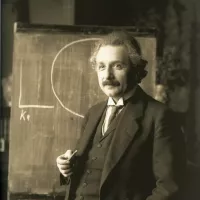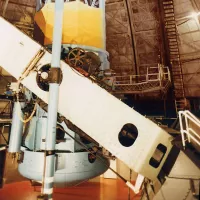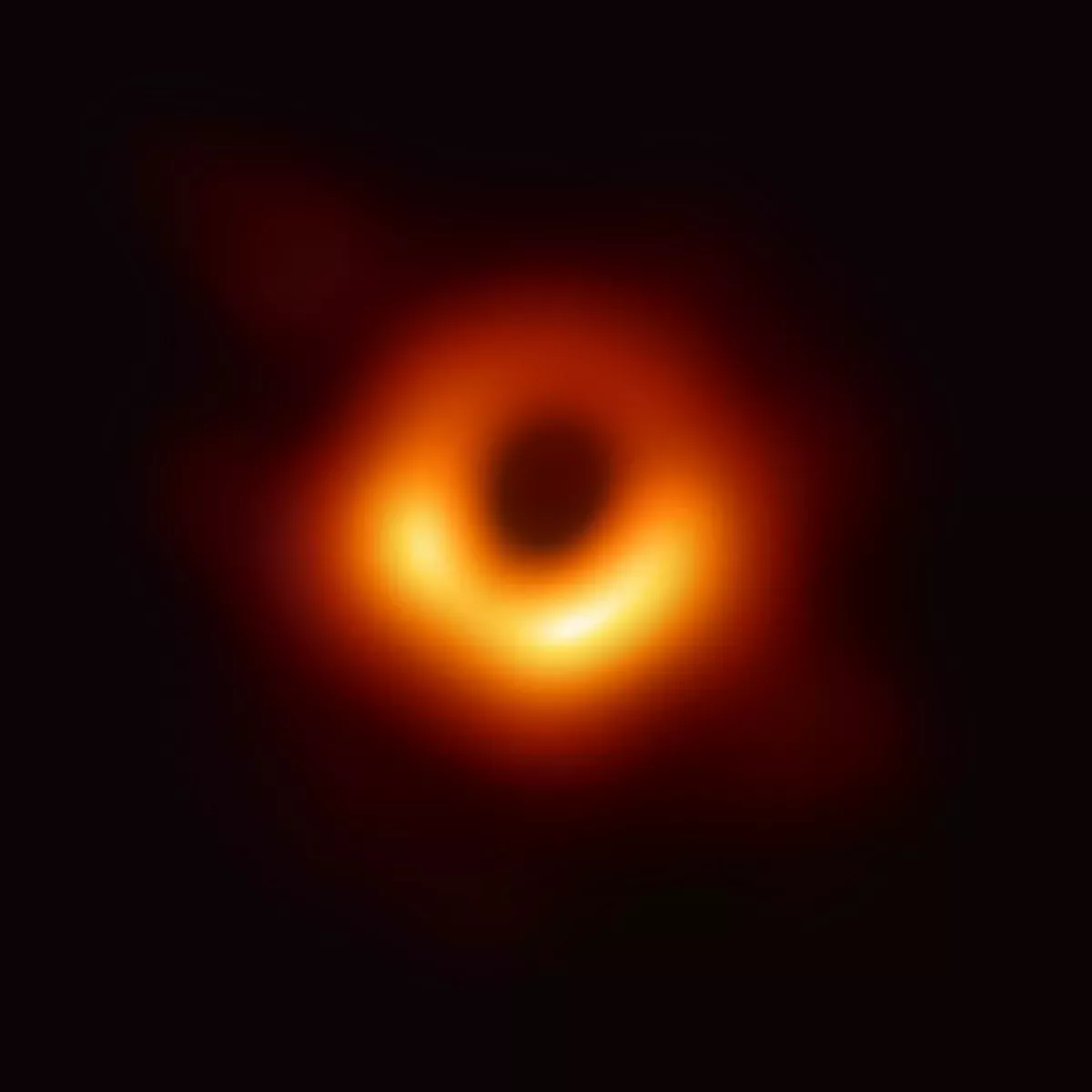Black holes are regions in spacetime with gravity so strong that nothing, not even light, can escape. Albert Einstein's theory of general relativity predicted their existence, stating that a sufficiently compact mass can deform spacetime to create one. The event horizon marks the boundary beyond which escape is impossible. While a black hole significantly affects objects crossing this boundary, general relativity suggests it has no locally detectable features, behaving like an ideal black body by reflecting no light. However, quantum field theory predicts that event horizons emit Hawking radiation, a thermal radiation similar to that of a black body, with a temperature inversely proportional to the black hole's mass. This temperature is extremely low for stellar black holes, making direct observation practically impossible.
1915: General Relativity and Black Hole Solutions
In 1915 Albert Einstein developed his theory of general relativity and Karl Schwarzschild found a solution to the Einstein field equations, describing the gravitational field of a point mass and a spherical mass, which had peculiar behaviour at what is now known as the Schwarzschild radius.
1915: Binary X-ray Source GRS 1915+105
The black hole candidate binary X-ray source GRS 1915+105 was observed, showing angular momentum.
1916: First Modern Black Hole Solution
In 1916, Karl Schwarzschild found the first modern solution of general relativity that characterized a black hole, leading to the Schwarzschild metric.
1916: Schwarzschild Black Holes
Karl Schwarzschild discovered the solution for static black holes with mass but no charge or angular momentum in 1916.
1924: Singularity Disappearance
Arthur Eddington showed that the singularity at the Schwarzschild radius disappeared after a change of coordinates in 1924.
1926: Star Density and Gravitational Effects
In 1926, Arthur Eddington discussed the implications of a star compressed to the Schwarzschild radius, noting that its gravity would prevent light from escaping and its spectral lines would be redshifted out of existence.
1931: Chandrasekhar Limit
Subrahmanyan Chandrasekhar calculated in 1931 that a non-rotating body of electron-degenerate matter above a certain mass limit has no stable solutions, leading to the concept of the Chandrasekhar limit.
1933: Non-Physical Coordinate Singularity
In 1933, Georges Lemaître realized that the singularity at the Schwarzschild radius was a non-physical coordinate singularity.
1939: Black Hole Existence Prediction
Oppenheimer and Hartland Snyder provided the Oppenheimer-Snyder model in their 1939 paper, predicting the existence of black holes using Einstein's theory of general relativity.
1939: Neutron Star Collapse Prediction
Robert Oppenheimer and others predicted in 1939 that neutron stars above the Tolman-Oppenheimer-Volkoff (TOV) limit would collapse further into black holes.
1958: Black Hole Defined
David Finkelstein published the interpretation of a "black hole" as a region of space from which nothing can escape in 1958.
1958: Event Horizon Identification
In 1958, David Finkelstein identified the Schwarzschild surface as an event horizon, a unidirectional membrane where causal influences can only cross in one direction.
1963: Rotating Black Hole Solution
Roy Kerr found the exact solution for a rotating black hole in 1963.
1963: Early Usage of "Black Hole"
The term "black hole" was used in print by Life and Science News magazines in 1963.
January 1964: "Black Holes" in Space
The term "black hole" appeared in Ann Ewing's article "'Black Holes' in Space" in January 1964, reporting on an AAS meeting.
1964: Cygnus X-1 Discovery
Cygnus X-1, a galactic X-ray source and the first astronomical object widely accepted to be a black hole, was discovered in 1964.
December 1967: John Wheeler and "Black Hole"
In December 1967, John Wheeler adopted the term "black hole" for its brevity and impact, popularizing its usage.
1967: Neutron Star Discovery
Jocelyn Bell Burnell's discovery of neutron stars in 1967 sparked interest in the astrophysical reality of collapsed compact objects like black holes.
1969: Pulsars as Rotating Neutron Stars
In 1969, pulsars were shown to be rapidly rotating neutron stars, demonstrating the physical relevance of compact objects formed by gravitational collapse.
1971: First Known Black Hole Identified
Cygnus X-1 was identified as the first known black hole by several researchers independently in 1971.
1971: Hawking's Area Theorem and Bekenstein's Entropy Proposal
In 1971, Stephen Hawking demonstrated that the total area of event horizons in a collection of classical black holes never decreases. This finding, similar to the second law of thermodynamics, led Jacob Bekenstein to propose that black holes possess entropy proportional to their horizon area.
1972: Discovery of Cygnus X-1
In 1972, Cygnus X-1 was identified as a strong black hole candidate by Charles Thomas Bolton, Louise Webster, and Paul Murdin. Initial uncertainties arose from the companion star's larger mass compared to the potential black hole.
1974: Hawking Radiation Prediction
In 1974, Stephen Hawking showed that quantum field theory predicts that black holes radiate like a black body, an effect now known as Hawking radiation.
1974: Hawking Radiation and Black Hole Thermodynamics
Stephen Hawking's 1974 discovery that black holes emit blackbody radiation further connected black holes to thermodynamics. This radiation, carrying energy and entropy, led to the formulation of the first law of black hole mechanics, with mass as energy, surface gravity as temperature, and area as entropy.
1995: Tracking Star Motions near Galactic Center
Astronomers began tracking the motions of stars near the center of the Milky Way in 1995.
1995: Microstates and Bekenstein-Hawking Entropy
In 1995, Andrew Strominger and Cumrun Vafa calculated the microstates of a supersymmetric black hole in string theory, confirming the Bekenstein-Hawking entropy. Similar results in string theory and loop quantum gravity provided further support for this connection.
1998: Evidence for Supermassive Black Hole
In 1998, astronomers found evidence for a supermassive black hole at the center of the Milky Way based on star motions.
2002: High-Energy Collisions and Black Hole Formation
As of 2002, no black holes have been detected in high-energy collisions, suggesting a lower limit for black hole mass.
November 2011: First Direct Observation of Quasar Accretion Disk
The first direct observation of a quasar accretion disk around a supermassive black hole was reported in November 2011.
2012: Firewall Paradox and Black Hole Complementarity
The "firewall paradox," proposed in 2012, challenged the black hole complementarity principle, which attempts to resolve the black hole information paradox. It argues that entanglement between emitted and infalling Hawking radiation particles creates a conflict with complementarity.
2014: Gargantua in Interstellar
In 2014, the science fiction film "Interstellar" featured a fictional black hole named Gargantua. It played a significant role in the movie’s plot, where it was part of a planetary system in a distant galaxy accessible via a wormhole.
September 2015: First Direct Observation of Gravitational Waves
LIGO made the first direct observation of gravitational waves, providing strong evidence for black holes, in September 2015.
2015: EHT Detection of Magnetic Fields
In 2015, the EHT detected magnetic fields near the event horizon of Sagittarius A*.
February 2016: First Direct Detection of Gravitational Waves
In February 2016, the first direct detection of gravitational waves was announced by LIGO and Virgo, confirming the existence of black hole mergers.
April 2017: EHT Observation of M87
In April 2017, the EHT began observing the black hole at the center of Messier 87.
2017: Event Horizon Telescope Observations
In 2017, the Event Horizon Telescope (EHT) made observations of the supermassive black hole in Messier 87's galactic center.
2018: Hawking's Death
Stephen Hawking, who contributed to the understanding of singularities, passed away in 2018.
April 2019: EHT Image of M87
In April 2019, the EHT released the first image of the M87 black hole.
April 2019: First Direct Image of a Black Hole
The first direct image of a black hole (M87) and its vicinity was published in April 2019, based on 2017 observations by the Event Horizon Telescope.
2020: Penrose Nobel Prize
Roger Penrose received half of the 2020 Nobel Prize in Physics for his work proving that singularities appear generically.
January 2022: First Confirmed Microlensing Event from an Isolated Black Hole
In January 2022, astronomers reported the first confirmed detection of a microlensing event caused by an isolated black hole, providing further evidence of their existence through gravitational lensing effects.
May 2022: EHT Image of Sagittarius A*
In May 2022, the EHT released the first image of Sagittarius A*, the supermassive black hole at the center of the Milky Way.
April 2023: Image of M87 Black Hole and Jet
In April 2023, an image of the M87 black hole's shadow and its high-energy jet was presented.
2023: Nearest Known Black Hole
As of 2023, Gaia BH1 is the nearest known black hole candidate, approximately 1,560 light-years away.
Mentioned in this timeline

One Direction D was a highly successful English-Irish pop boy...

Albert Einstein - was a German-born theoretical physicist renowned for...
NASA the National Aeronautics and Space Administration is an independent...

News encompasses information about current events disseminated through various media...

A telescope is an instrument used to observe distant objects...

A star is a self-gravitating luminous plasma spheroid The Sun...
Trending

2 months ago Texas Senate Candidate Talarico Faces Social Media Scrutiny: Following Porn Actors Sparks Controversy
The Harlem Globetrotters are an American exhibition basketball team renowned for their unique blend of athleticism comedy and theatrical entertainment...
1 month ago Pakistan to bowl first after winning toss against Sri Lanka T20 Tri-Series
1 month ago GameStop's Valuation, Investor Sentiment, Burry's Email, and Strategic Shifts Analyzed.
1 month ago Bangladesh Levels T20 Series Against Ireland; Shamim Returns Amidst Selector Disputes.

2 months ago Kehlani, Kali Uchis, and EJAE to be Honored at 2025 ASCAP Event
Popular

Stranger Things created by the Duffer Brothers is a popular...

XXXTentacion born Jahseh Dwayne Ricardo Onfroy was a controversial yet...

Kelsey Grammer is an accomplished American actor producer and singer...

Candace Owens is an American conservative political commentator and author...

Bernie Sanders is a prominent American politician currently serving as...

Melania Trump a Slovenian-American former model has served as First...
